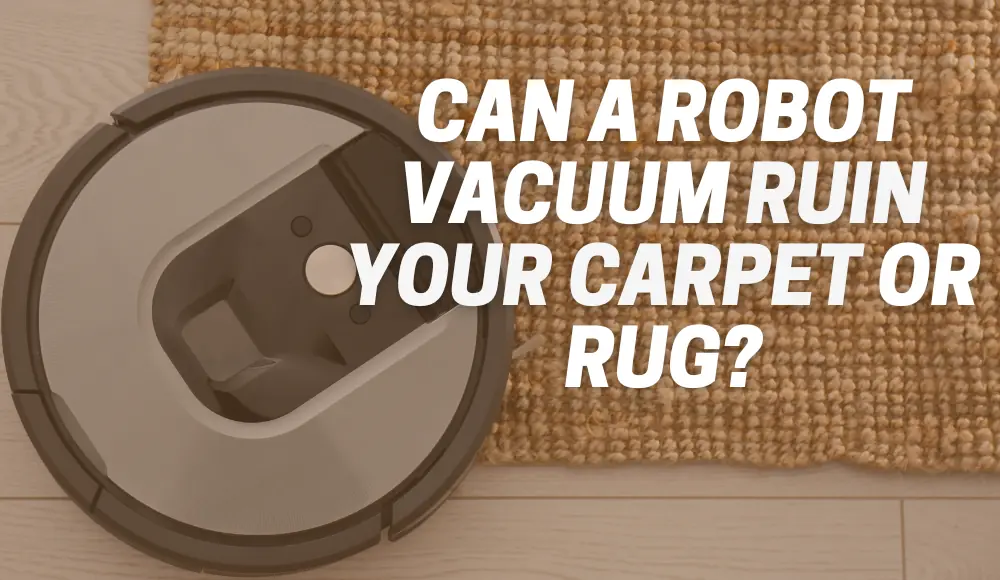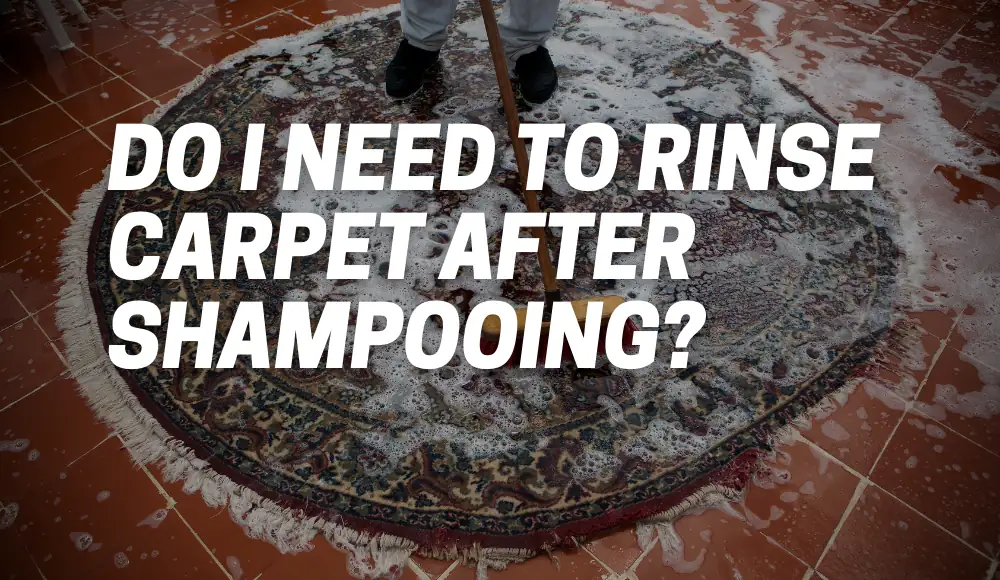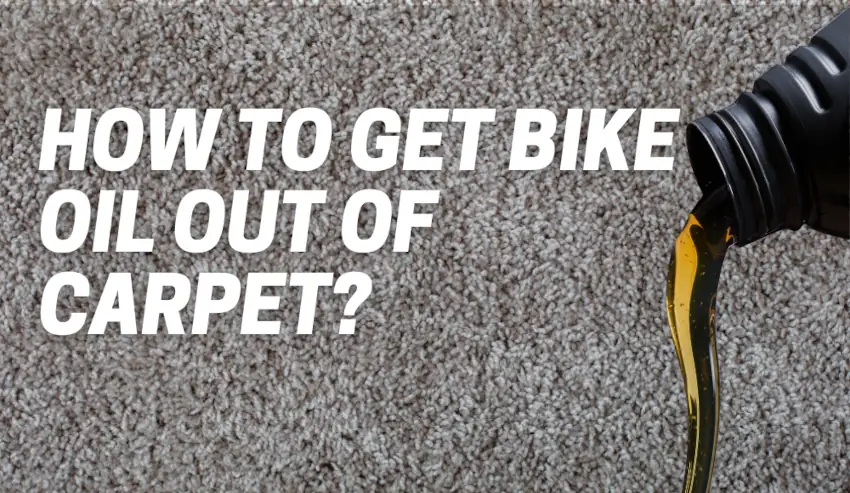Last updated on August 26th, 2023 at 03:02 am
Robot vacuums have become increasingly popular in recent years, revolutionizing the way we clean our homes. These automated devices offer convenience and efficiency, but when it comes to carpeted areas, many homeowners have concerns. In this article, we will explore the question, “Can a robot vacuum ruin your carpet or rug?” and provide insights to help you make an informed decision.
We’ll also address specific concerns about using robot vacuums on wool carpets, rugs, and the differences between popular brands like Roomba and Shark.
So, let’s dive in!
How Robot Vacuums Work
First things first.
Robot vacuums are designed to navigate and clean floors automatically, without any human input. This has made cleaning much easier for people who lead busy lives or simply don’t enjoy the task.
However, there is one concern that often arises – can robot vacuums ruin your carpets or rugs?
To understand how robot vacuums may impact your carpets or rugs, it’s important to first understand how they work.
Most robot vacuums use sensors and mapping technology to navigate around a room. These sensors allow the vacuum to detect obstacles and avoid them while mapping technology allows it to remember the layout of a room.
Navigation
The navigation system of a robot vacuum is typically based on either infrared sensors or laser sensors. Infrared sensors work by emitting beams of light and measuring how long it takes for that light to reflect back off an object in the room.
Laser sensors operate similarly, but use beams of laser light instead. These sensors allow the robot vacuum to detect walls, furniture, and other obstacles in its path so that it can maneuver around them without colliding.
Brush Types
Different types of brushes are used by robot vacuums depending on their design and intended use. The most common types of brushes include spinning brushes, brush bars with bristles, and rubberized brushes.
- Spinning brushes are typically found on the front or sides of a vacuum and spin rapidly as they sweep across floors.
- Brush bars with bristles use long strands of stiff nylon bristles that agitate dirt from carpets as they rotate.
- Rubberized brushes are designed for hardwood floors or tiling since they’re not as effective at agitating dirt from thick carpets as bristle brush bars do but instead are more efficient at pushing debris into the suction chamber.
Ultimately regardless of what brush type is used by your robot vacuum, it’s important to understand how it can impact your carpets and rugs to prevent any damage from occurring.
Are Robot Vacuums OK for Carpet?
Robot vacuums are generally safe to use on carpets, thanks to their advanced technologies and thoughtful design.
However, it’s crucial to choose a robot vacuum specifically designed for cleaning carpets to ensure optimal performance.
These specialized robot vacuums are equipped with powerful suction, brush systems, and sensors that detect different surfaces, including carpets.
By investing in a robot vacuum designed for carpets, you can effectively remove dirt, debris, and pet hair from your carpets without causing damage.
These intelligent machines adjust their cleaning methods based on the carpet’s texture and pile, ensuring thorough cleaning without compromising the carpet’s integrity.
Can I Use a Robot Vacuum on Wool Carpet?
Wool carpets are known for their luxurious feel and delicate fibers. Naturally, you may be concerned about using a robot vacuum on such a valuable investment.
The good news is that many robot vacuums are specifically engineered to clean wool carpets safely.
When selecting a robot vacuum for wool carpets, look for features like:
- adjustable suction power
- gentle brush systems
- and advanced sensors.
These features allow the robot vacuum to adapt its cleaning technique to protect the delicate fibers of your wool carpet while still achieving effective cleaning results.
Remember to always check the manufacturer’s recommendations for your specific robot vacuum model and follow any guidelines provided to ensure the best care for your wool carpet.
How Some Types of Carpets and Rugs Are More Susceptible
While all carpets and rugs have the potential to be damaged by robot vacuums if not used properly, some types are definitely more susceptible than others.
For instance, an antique rug with delicate fringes should never be cleaned with a robot vacuum as it could easily snag or tear the fibers.
Similarly, any carpet with loose threads or tassels could also become entangled in the brushes of a robot vacuum leading to damage over time.
When considering whether or not you want to use your robot vacuum on your carpets or rugs – take into account both the materials used and their specific texture before letting your trusty machine take over.
Can You Use a Robot Vacuum on Rugs?
Yes, you can use a robot vacuum on rugs! Rugs, whether they are area rugs or smaller accent rugs, can benefit from the convenience of a robot vacuum.
Just like with carpets, it’s essential to choose a robot vacuum that is suitable for rug cleaning.
Do robot vacuums damage rugs?
Robot vacuums designed for rugs have features that allow them to navigate and clean these surfaces effectively. They often include specialized brush systems to dislodge dirt and debris from rug fibers, ensuring a thorough cleaning.
Additionally, these robot vacuums may have sensors that detect rug edges to prevent falls or damage.
With a robot vacuum, you can maintain the cleanliness of your rugs without the hassle of manual vacuuming, saving you time and effort.
Can You Ruin Carpet from Vacuuming?
Vacuuming is an essential part of carpet maintenance, but can it ruin your carpet? When done correctly and with the right equipment, vacuuming should not damage your carpet.
However, improper vacuuming techniques or using a vacuum not suitable for your carpet type can lead to problems.
For example, using a vacuum cleaner with excessively strong suction power or a beater bar on a delicate carpet can cause fraying, fiber damage, or even pull out carpet threads.
Additionally, abrasive brushes or worn-out brush heads can scratch or wear down the carpet fibers over time.
To avoid potential damage, it’s important to select a vacuum cleaner, including a robot vacuum, that is compatible with your carpet type.
Follow the manufacturer’s guidelines, adjust the vacuum’s settings accordingly, and regularly inspect the brushes and rollers for signs of wear.
Potential Risks to Carpets and Rugs from Robot Vacuums
The Danger of Snagging
One of the most common risks associated with using a robot vacuum on carpets or rugs is snagging.
This occurs when the vacuum’s brushes become entangled in loose fibers or tassels on the carpet or rug, which can cause damage and potentially ruin the material. In order to avoid this risk, it’s important to regularly check for loose fibers and tassels before running your robot vacuum over the carpet or rug.
Fearing Fraying
Another potential risk to carpets and rugs from robot vacuums is fraying. This can occur when the vacuum’s brushes pull at the edges of a carpet or rug, causing wear and tear over time.
To prevent fraying, it’s important to avoid using certain cleaning modes such as spot cleaning or edge cleaning, which can be too rough on delicate materials.
Additionally, using a lower suction setting may help reduce the risk of fraying.
The Problem with Debris
Certain types of debris can also pose a risk to carpets and rugs when not properly cleaned up before vacuuming.
For example, small rocks or hard objects may get lodged in between fibers causing damage as they are pulled out by the robot vacuum’s brushes. It’s important to properly sweep up larger debris before running your robot vacuum on carpets or rugs in order to minimize the risk of damage.
Overall, while there are risks involved with using a robot vacuum on carpets and rugs these risks can be minimized with proper care and attention.
By following preventative measures like regularly checking for loose fibers and avoiding certain cleaning modes, you can enjoy all the benefits of having a robot helper clean your floors without worrying about damaging your beloved area rugs.
Preventative Measures
Regularly Check for Loose Fibers or Tassels
One of the simplest preventative measures to take when using a robot vacuum is to regularly check your carpets and rugs for loose fibers or tassels.
This is especially important if you have a carpet or rug with a high pile, as the robot vacuum can easily snag and damage these fibers.
Take some time before using your robot vacuum to inspect your carpets and rugs, and remove any loose fibers or tassels that may be present. This will help ensure that your robot vacuum doesn’t cause any unnecessary damage.
Avoid Certain Cleaning Modes
Most robot vacuums offer multiple cleaning modes, such as spot cleaning or deep cleaning. While these modes can be useful for certain situations, they can also be more aggressive on carpets and rugs than other cleaning modes.
If you’re concerned about potential damage to your carpets or rugs, it’s best to avoid these more aggressive cleaning modes and stick with a basic cleaning mode instead.
Not only will this help prevent damage to your floors, but it may also extend the life of your robot vacuum by limiting wear-and-tear on its brushes.
Clean Your Floors Before Vacuuming
Another important preventative measure is to make sure that your floors are free from debris before running your robot vacuum.
While most models come equipped with sensors that detect obstacles and adjust their cleaning pattern accordingly, larger pieces of debris can still get caught in the brushes and cause damage if not properly removed beforehand.
Take some time to sweep or pick up any larger debris on your floors before running the robot vacuum so that it can safely clean without causing any unnecessary damage.
Adjust Brush Height (If Possible)
Some newer models of robot vacuums come equipped with adjustable brush height settings, which allow you to raise or lower the brushes depending on the type of floor surface you’re cleaning.
If your robot vacuum has this feature, it’s important to adjust the brush height accordingly when cleaning carpets or rugs.
This will help prevent the brushes from getting too deep into the fibers and causing damage.
Can You Vacuum a Rug Too Much?
While vacuuming is necessary to maintain the cleanliness of your rugs, excessive vacuuming can cause wear and tear over time.
The frequency of vacuuming depends on various factors such as foot traffic, pets, and the type of rug.
For high-traffic areas or rugs that attract a significant amount of dirt, vacuuming once or twice a week is typically recommended.
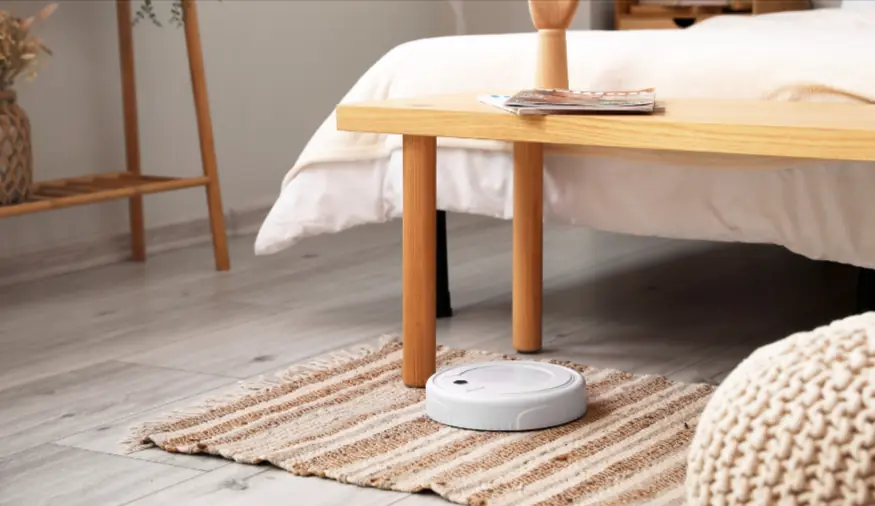
However, for less frequently used rugs or those in low-traffic areas, vacuuming once every two weeks may be sufficient.
Over-vacuuming can lead to the flattening of rug fibers, which affects the rug’s appearance and texture. If you notice your rug losing its fluffiness or becoming flat, it may be an indication that you are vacuuming too frequently.
Remember, it’s important to strike a balance between keeping your rugs clean and preserving their longevity.
Regular vacuuming is beneficial, but excessive vacuuming should be avoided to prevent unnecessary wear.
What Are the Bad Things About Robot Vacuums?
While robot vacuums offer numerous advantages, it’s essential to consider some potential drawbacks:
- Limited Deep Cleaning: Robot vacuums are great for day-to-day maintenance cleaning but may not replace the need for occasional deep cleaning, especially for heavily soiled carpets or rugs.
- Staircase and Elevated Surfaces: Robot vacuums cannot navigate stairs or climb elevated surfaces. If you have multiple floors in your home, you’ll still need a traditional vacuum or other cleaning methods for those areas.
- Obstacles and Tangles: Some robot vacuums may struggle with maneuvering around obstacles or getting tangled in cords. Ensuring a clutter-free environment can help prevent these issues.
- Higher Initial Investment: Robot vacuums can be more expensive than traditional vacuums. However, the added convenience and time-saving benefits may outweigh the higher cost for many users.
By being aware of these limitations, you can make an informed decision and set realistic expectations when considering a robot vacuum for your carpet or rug cleaning needs.
Are Robot Vacuums Really Worth It?
Determining whether a robot vacuum is worth it depends on your specific needs, lifestyle, and budget. Here are some points to consider:
- Convenience: Robot vacuums offer hands-free cleaning, allowing you to focus on other tasks or simply relax while the vacuum does the work for you.
- Time-Saving: With a robot vacuum, you can maintain cleaner carpets and rugs without spending as much time on manual vacuuming.
- Regular Maintenance: Robot vacuums are particularly useful for routine maintenance cleaning, preventing dirt and debris from accumulating and making deep cleaning sessions less frequent.
- Smart Features: Many robot vacuums come with advanced features such as scheduling, app control, and mapping capabilities, allowing you to customize your cleaning preferences and adapt to your lifestyle.
Ultimately, the decision of whether a robot vacuum is worth it depends on your personal preferences and circumstances.
If the convenience and time-saving aspects align with your needs, a robot vacuum can be a valuable addition to your cleaning routine.
Is Roomba Safe on Rugs?
Roomba, one of the most popular robot vacuum brands, is generally safe to use on rugs.
Roomba models are equipped with advanced sensors and algorithms that enable them to detect and navigate various surfaces, including rugs. They can effectively clean rugs without causing damage or leaving unsightly marks.
Roomba robot vacuums are designed to adjust their cleaning methods based on the surface they encounter. They can automatically adapt to rug fibers, ensuring thorough cleaning while protecting the rug’s integrity.
Can iRobot damage carpet?
While iRobot Roomba vacuums have safety features and sensors to navigate and avoid obstacles, there is still a small risk of accidental damage or issues. It’s always a good idea to monitor the vacuum’s operation, especially during its initial uses on a carpeted area, to ensure it’s working properly and not causing any damage.
To ensure optimal performance, always check the specific recommendations provided by the manufacturer for your Roomba model and the type of rug you have.
Does Roomba Leave Carpet Marks?
When used correctly and according to the manufacturer’s instructions, Roomba robot vacuums should not leave visible marks on carpets.
However, several factors can contribute to the appearance of carpet marks, such as:
- Worn or Damaged Carpet: If your carpet is already worn or damaged, the vacuum’s brushes and wheels may accentuate these imperfections, resulting in visible marks.
- Excessive Friction: If the robot vacuum’s brushes or wheels are not properly maintained or become worn out, they may create excessive friction against the carpet, potentially causing marks.
- Incorrect Settings: Using the wrong cleaning mode or excessive suction power on delicate carpets can lead to marks or damage.
It is important to understand the causes why a Roomba vacuum robot may leave the marks on carpet – is this because of the robot vacuums or the carpet?
A good option here also is to search for advice and recommendations on talk boards and forums, such as subreddits.
For instance, on one of the subreddits, a user claimed the Roomba leaving unpleasant carpet marks and asked for advice.
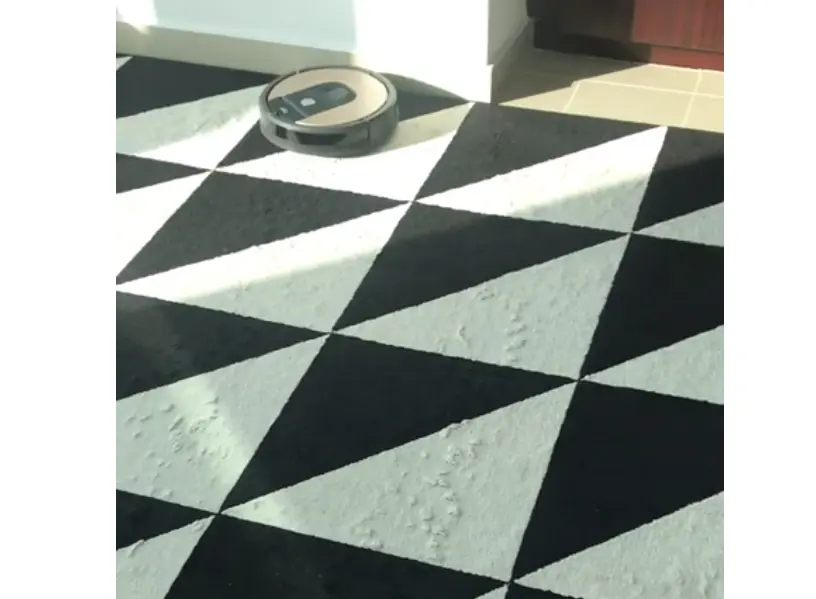
Here are some observations and advice shared by other Roomba users on Reddit:
| Comment |
|---|
| Similar marks on plain old brown carpet. Has an i7 Roomba and expects replacement rollers soon. |
| Has an exact rug from Ikea. Roombas have difficulty coping with it as they interpret the black sections as cliffs. Neato robot vacuum handles it without any issues. |
| Older Roombas can’t handle dark rugs as they interpret them as cliffs. Suggests using an i7 or S9 Roomba for that rug. |
| Taped over cliff-sensors on their Roomba to fix the issue. |
| The rug is throwing off the Roomba’s sensors. |
| Marks on the rug are due to the material it is made of. Suggests using a broom to lay the fibers back down. |
| Claims running a regular vacuum over the rug would have the same effect. |
| Regular vacuuming would not be as costly as buying a good Roomba. |
| Claims their normal vacuum does not leave marks like the Roomba does. |
| Explains that the Roomba’s erratic movement due to cliff sensors and jerking around is causing the marks. States any vacuum with rollers will leave lines on the carpet. |
If Roomba keeps getting stuck on cliff or interprets the black sections on the carpet as cliffs, there is an option to disable the cliff sensors:
—
To minimize the risk of carpet marks, ensure your Roomba is well-maintained, follow the manufacturer’s guidelines, and regularly inspect the brushes and wheels for wear.
Additionally, consider using lower suction power or gentle cleaning modes for delicate carpets.
Is Shark Robot Good on Carpet?
Shark is another well-known brand in the robot vacuum market, offering a range of models suitable for various floor types, including carpets.
Shark robot vacuums generally perform well on carpets, thanks to their strong suction power and efficient brush systems.
Can I use Shark robot vacuum on carpet?
These robot vacuums are designed to effectively remove dirt, debris, and pet hair from carpets, providing a thorough cleaning.
Many Shark models also feature intelligent sensors that detect carpeted areas and adjust the cleaning mode accordingly.
To ensure optimal performance, it’s important to select a Shark robot vacuum that is specifically designed for carpet cleaning. Check the product specifications and customer reviews to determine which model best suits your carpet cleaning needs.
Does Shark EZ robot work on carpet?
Yes, the Shark EZ Robot is designed to work on carpets. Its powerful suction and multi-surface brushroll allow it to effectively tackle large debris, small debris, and stuck-on dust on both floors and carpets.
However, it is suggested to remember not to expect exceptionally well performance on carpets from any robot vacuum model. While the vacuum may pick up some debris and pet hair from carpets, it may not have enough suction power to thoroughly clean carpets compared to a traditional upright vacuum cleaner. It is important to set realistic expectations regarding its carpet cleaning capabilities.
What Is the Difference Between Shark and Roomba Robot Vacuum?
Shark and Roomba are two prominent brands in the robot vacuum market, each offering unique features and technologies.
Here are some key differences between Shark and Roomba robot vacuums:
- Design and Navigation: Shark robot vacuums often feature a more traditional vacuum design, with a wider cleaning path and a larger dustbin capacity. Roomba vacuums, on the other hand, typically have a round shape and use advanced navigation systems to efficiently clean different areas.
- Cleaning Modes and Performance: Both brands offer multiple cleaning modes, including spot cleaning, edge cleaning, and scheduled cleaning. Roomba vacuums are known for their efficient mapping capabilities, while Shark vacuums often prioritize powerful suction and deep cleaning.
- Price Range: Shark robot vacuums generally offer a more budget-friendly range compared to Roomba vacuums. However, the price varies depending on the specific model and its features.
- Brand Reputation and Support: Roomba is a well-established brand with a long history of producing reliable robot vacuums. Shark has gained popularity in recent years and is known for its strong customer support.
When choosing between Shark and Roomba robot vacuums, consider your specific cleaning needs, budget, and desired features.
Reading customer reviews and comparing models side by side can help you make an informed decision.
Do Robot Mops Avoid Carpet?
Yes, robot mops typically avoid carpeted areas. Robot mops are specifically designed to mop hard floors and are equipped with sensors that detect carpeted surfaces. These sensors allow the robot mop to navigate around carpets and rugs, avoiding any contact or potential damage.
When using a robot mop, it’s important to ensure that the mop’s sensors are functioning properly and that the area you want to be mopped does not include any carpets.
This way, you can enjoy the convenience of automated mopping without worrying about your carpets getting wet or damaged.
FAQs:
How Do I Keep My Robot Vacuum Off My Rug?
To keep your robot vacuum off your rug, you can use the following methods:
- Physical Barriers: Place physical barriers, such as small gates or magnetic strips, around the perimeter of the rug to prevent the robot vacuum from accessing it.
- Virtual Walls: Many robot vacuum models offer virtual wall or boundary-setting features. Use these features to create a virtual boundary around the rug, instructing the robot vacuum to avoid the area.
- Rug Weight: Some robot vacuums may have difficulty moving on heavier rugs. If your rug is heavy enough, it may act as a natural barrier, preventing the robot vacuum from getting onto the rug.
How Often Do You Have to Vacuum a Carpet?
The frequency of vacuuming depends on factors such as foot traffic, the presence of pets, and individual circumstances. In general, it is recommended to vacuum high-traffic areas at least once a week and less frequently used areas every two weeks.
Regular vacuuming helps remove dirt, dust, and allergens, keeping your carpet clean and prolonging its lifespan. However, adjust the frequency based on your specific needs and the condition of your carpet.
Conclusion:
Choosing a robot vacuum for your carpet or rug cleaning needs can be a wise investment. With the right model designed specifically for carpets, you can maintain clean and fresh carpets without compromising their quality.
Whether you opt for a Roomba, Shark, or any other reputable brand, ensure you follow the manufacturer’s guidelines, perform regular maintenance, and adjust the settings accordingly.
By understanding the benefits and limitations of robot vacuums, you can make an informed decision that aligns with your needs and preferences.
Embrace the convenience and efficiency of robot vacuums, and enjoy cleaner carpets and rugs with less effort on your part.
